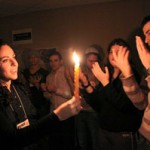What the rabbi reads – Emor
 I was once the visiting rabbi at a certain congregation.
I was once the visiting rabbi at a certain congregation.
As the synagogue was between rabbis, the official residence was made available for my wife’s and my accommodation. It was a highly impressive mansion in its own grounds, and we were very comfortable there.
However, the previous rabbi, as one would expect, had taken his library with him, and it was disconcerting to see rows of empty bookshelves. Actually one shelf was not quite empty. The congregational powers-that-be had put in a few books for me to read.
The only problem was that they were sermon collections produced by two previous incumbents. Nonetheless I did browse through the sermon books and found myself impressed at the quality of the preachers who had written them.
One sermon which stuck in my mind was on this week’s parashah of Emor, which contains the command to demarcate between the permitted and the profane.
On this verse the preacher had said that on that sentence rested the definition of Judaism. Judaism, he said, was the wisdom to know the difference between the wrong and the right, the unclean and the clean, that which was allowed and that which was prohibited.
I took the idea back to my own pulpit and developed it as the concept behind the Havdalah ceremony at the end of Shabbat.
What Havdalah symbolises at the beginning of the workday week is that the beginning and end of being Jewish is the ability to know the difference between holy and profane (spiritual and the non-spiritual); between light and darkness (truth and falsehood); between Israel and the peoples (different expressions of identity); between the Sabbath and the six working days (different attitudes to time).



